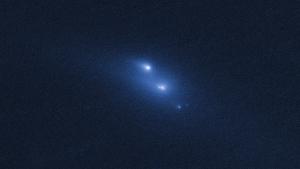Blog
Super Breakout
8 March 2014
 NASA/ESA
NASA/ESARecently an asteroid has been observed while breaking apart. What makes this particularly interesting is that it doesn’t seem to be due to a collision, but rather due to the effects of sunlight. The first analysis of this asteroid was presented this week in the Astrophysical Journal Letters.1
The asteroid was observed breaking up over the past several months. The fact that it happened gradually, and that the fragments are moving along the same general direction as the original asteroid, is an indication that this is not due to a collision with another asteroid. This is very unusual, because the asteroid was in a circular orbit within the main region of the asteroid belt. So the breakup was also not due to gravitational stress during a close approach with another large body.
 NASA, ESA, D. Jewitt (UCLA), and A. Feild (STScI)
NASA, ESA, D. Jewitt (UCLA), and A. Feild (STScI)What is most likely is that the asteroid was loosely packed, perhaps fractured by an earlier collision. Over time sunlight pressure caused the asteroid to rotate ever faster. Eventually the rotation was great enough that the asteroid was flung apart.
 Wikipedia
WikipediaIt might seem odd that sunlight can cause an asteroid to rotate, but it is actually an effect known as the Yarkovsky–O’Keefe–Radzievskii–Paddack effect, or YORP effect for short. If you’ve ever seen a radiometer spin when exposed to sunlight, you’ve seen a similar effect. Although light doesn’t have mass, it does have momentum, and that momentum can push an asteroid very slightly. With an asymmetrical asteroid, the amount of light pressure on different parts of an asteroid can be different. Over millions of years this imbalance can cause the asteroid to gradually spin faster.
We’ve observed this effect before, and now it seems the effect can rotate small, loose asteroids to the point that they break apart. This may actually be more common than breakups due to collisions.
Jewitt, David, et al. “Disintegrating asteroid P/2013 R3.” The Astrophysical Journal Letters 784.1 (2014): L8. ↩︎